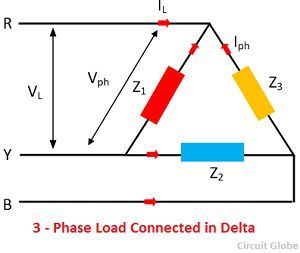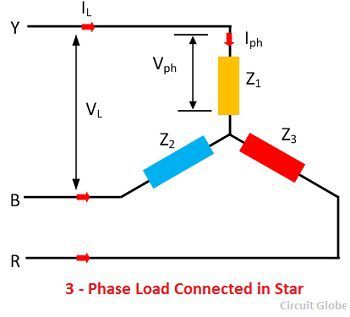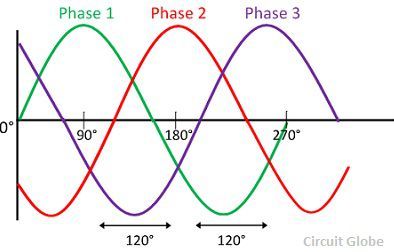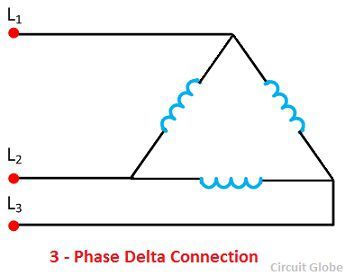Definition: The system which has three phases, i.e., the current will pass through the three wires, and there will be one neutral wire for passing the fault current to the earth is known as the three phase system. In other words, the system which uses three wires for generation, transmission and distribution is known as the three phase system. The three phase system is also used as a single phase system if one of their phase and the neutral wire is taken out from it. The sum of the line currents in the 3-phase system is equal to zero, and their phases are differentiated at an angle of 120º
The three-phase system has four wire, i.e., the three current carrying conductors and the one neutral. The cross section area of the neutral conductor is half of the live wire. The current in the neutral wire is equal to the sum of the line current of the three wires and consequently equal to √3 times the zero phase sequence components of current.
The three-phase system has several advantages like it requires fewer conductors as compared to the single phase system. It also gives the continuous supply to the load. The three-phase system has higher efficiency and minimum losses.
The three phase system induces in the generator which gives the three phase voltage of equal magnitude and frequency. It provides an uninterruptible power, i.e., if one phase of the system is disturbed, then the remaining two phases of the system continue supplies the power.The magnitude of the current in one phase is equal to the sum of the current in the other two phases of the system.
The 120º phase difference of the three phases is must for the proper working of the system. Otherwise, the system becomes damaged
Types of Connections in Three-Phase System
The three-phase systems are connected in two ways, i.e., the star connection and the delta connection. Their detail explanation is shown below.
Star Connection
The star connection requires four wires in which there are three phase conductors and one neutral conductor. Such type of connection is mainly used for long distance transmission because it has a neutral point. The neutral point passes the unbalanced current to the earth and hence make the system balance.
The star connected three phase systems gives two different voltages, i.e., the 230 V and 440V. The voltage between the single phase and the neutral is 230V, and the voltage between the two phases is equal to the 440V.
Delta Connection
The delta connection has three wires, and there is a no neutral point. The delta connection is shown in the figure below. The line voltage of the delta connection is equal to the phase voltage.
Connection of Loads in Three Phase System
The loads in the three-phase system may also connect in the star or delta. The three phase loads connected in the delta and star is shown in the figure below.


The three phase load may be balanced or unbalanced. If the three loads (impedances) Z1, Z2 and Z3 has the same magnitude and phase angle then the three phase load is said to be a balanced load. Under balance condition, all the phases and the line voltages are equal in magnitude.




Nice work.when was this published
what a good job!
Thank you for your information.
The value label on the first figure is wrong. The phase difference between two consequence peak is 120. The second peak (phase 2) is at 210 …
The phase 1 ends up its period at 360, so on…
thank you very much
Thanks so much for the knowledge you people have added to me. I have understood how 3 phase works. Thanks